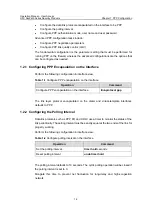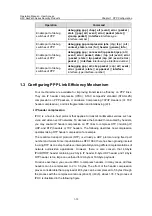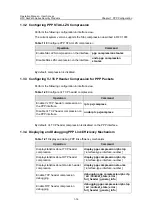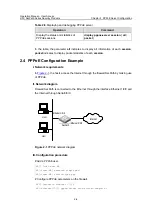
Operation Manual – User Access
H3C SecPath Series Security Products
Chapter 1 PPP Configuration
1-9
Table 1-9
Assign directly the specified IP address for the peer on the interface
Operation
Command
Assign an IP address for the PPP user
remote
address
ip-address
Remove the configuration
undo
remote
address
By default, if the
remote
address
pool
command and the domain address pool are not
configured, the specified IP address is not assigned for the peer on the interface.
Method 2: Assign an IP address for the peer using a global address pool
Define a global address pool in system view first, and then use the
remote
address
pool
command on the interface to specify a global address pool number (only one
number can be specified).
Table 1-10
Assign an IP address for the peer using a global address pool
Operation
Command
Define a global IP address pool
ip pool
pool-number low-ip-address
[
high-ip-address
]
Remove the configuration
undo
ip
pool
pool-number
Use the global address pool to assign an
IP address for the PPP user
remote
address
pool
[
pool-number
]
Remove the configuration
undo
remote
address
By default, if the
remote
address
pool
command and the domain address pool are not
configured, the IP address is not assigned for the peer. When you configure the
remote
address pool
command but do not configure the
pool-numbe
r parameter, the system
uses global address pool 0 by default.
If you do not authenticate the PPP user, you can use methods 1 and 2. If you need to
authenticate the PPP user, you should use method 3 as follows:
Method 3: Assign an IP address for the peer using the address pool for the domain
Define a address pool for the domain in domain view first, and then use the
remote
address
pool
command to specify the address pool number for the domain (you can
specify only one number); if you do not configure the
remote
address
pool
command,
use the address pools of the corresponding domains in turn to assign IP addresses for
users during authentication negotiation.


























